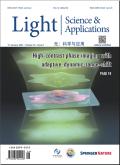Germanium disulfide as an alternative high refractive index and transparent material for UV-visible nanophotonics.
IF 20.6
Q1 OPTICS
引用次数: 0
Abstract
Thanks to their record high refractive index and giant optical anisotropy, van der Waals (vdW) materials have accelerated the development of nanophotonics. However, traditional high refractive index materials, such as titanium dioxide (TiO2), still dominate in the most important visible range. This is due to the current lack of transparent vdW materials across the entire visible spectrum. In this context, we propose that germanium disulfide (GeS2) could offer a significant breakthrough. With its high refractive index, negligible losses, and biaxial optical anisotropy across the whole visible range, GeS2 has the potential to complement TiO2 and close the application gap of vdW materials in the visible spectrum. The addition of GeS2 could have a profound impact on the design of van der Waals nanophotonic circuits for any operation wavelength from ultraviolet to infrared, emphasizing the significance of the potential impact of GeS2 on the field of nanophotonics.二硫化锗作为一种高折射率、透明的紫外可见纳米光子学材料。
由于其高折射率和巨大的光学各向异性,范德华(vdW)材料加速了纳米光子学的发展。然而,传统的高折射率材料,如二氧化钛(TiO2),在最重要的可见光范围内仍然占主导地位。这是由于目前缺乏整个可见光谱的透明vdW材料。在这种情况下,我们提出二硫化锗(GeS2)可以提供一个重大的突破。GeS2具有高折射率、可忽略的损耗和在整个可见光范围内的双轴光学各向异性,有可能与TiO2互补,填补vdW材料在可见光光谱中的应用空白。GeS2的加入可能对从紫外到红外的任何工作波长的范德华纳米光子电路的设计产生深远的影响,强调了GeS2在纳米光子学领域的潜在影响的重要性。
本文章由计算机程序翻译,如有差异,请以英文原文为准。
求助全文
约1分钟内获得全文
求助全文
来源期刊

Light-Science & Applications
数理科学, 物理学I, 光学, 凝聚态物性 II :电子结构、电学、磁学和光学性质, 无机非金属材料, 无机非金属类光电信息与功能材料, 工程与材料, 信息科学, 光学和光电子学, 光学和光电子材料, 非线性光学与量子光学
自引率
0.00%
发文量
803
审稿时长
2.1 months
 求助内容:
求助内容: 应助结果提醒方式:
应助结果提醒方式:


